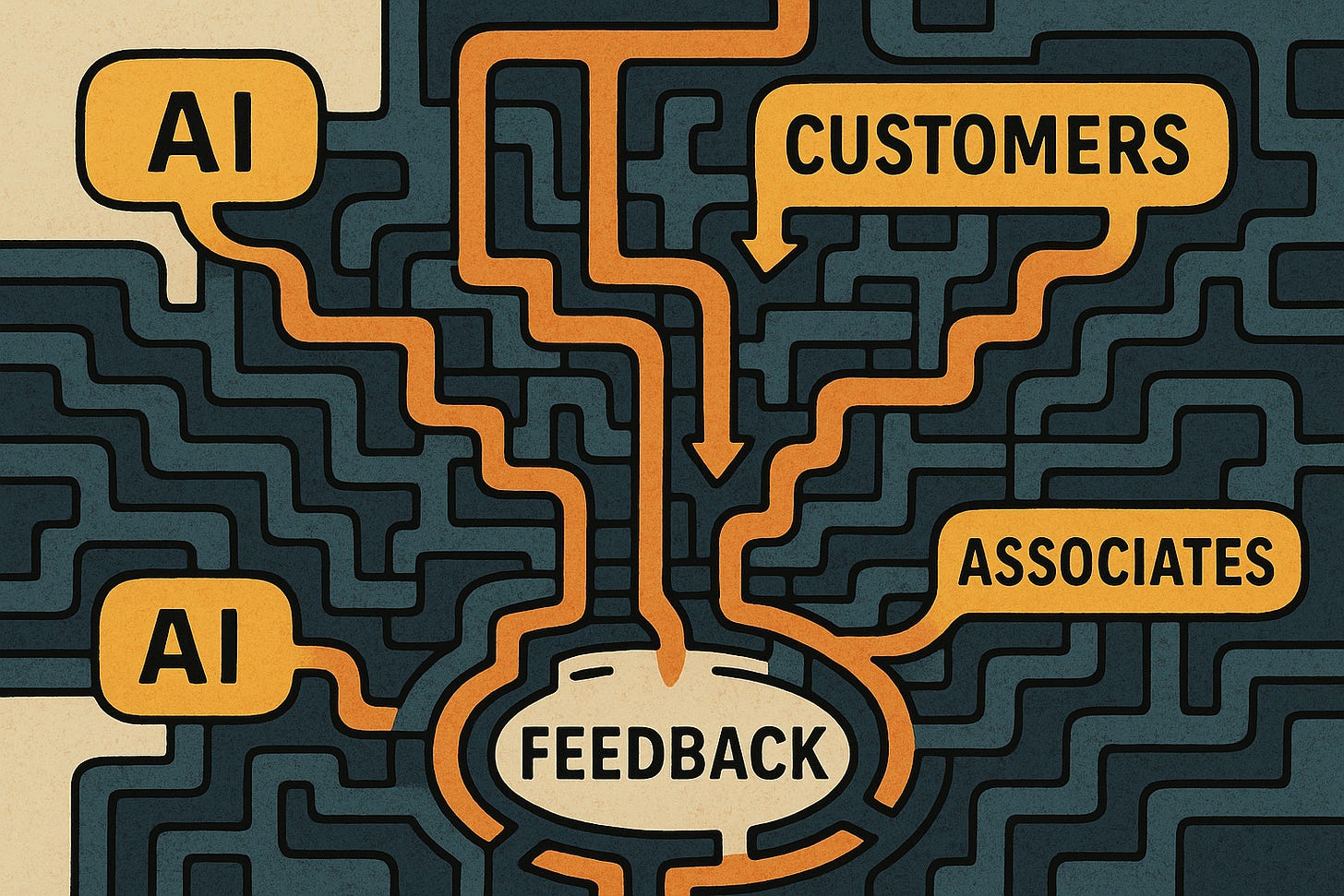🚀 The Gift of Feedback: Why Retail Needs to Listen More Than It Speaks
Unlocking Growth One Honest Conversation at a Time
A featured guest on an upcoming episode of Retail Relates put it bluntly:
“AI is absolutely going to take over - it’s evolving every day! What we have to think about is how we use it. Too many are asking it to do the work for them - create a new social media campaign. Instead, use it to challenge your ideas, poke holes, give you feedback on how you can make them better.”
That statement wasn’t about automation. It was about honest input - the kind that makes ideas better, sharper, and more relevant. It raised a critical question for retail:
Are we really listening to feedback? Or are we just collecting data that reinforces what we already believe?
Retailers Hear Their Customers - But Are They Really Listening?
The retail industry is built on responsiveness. Customer reviews, net promoter scores, in-store experience trackers, AI-enabled analytics - retailers are awash in customer data. But having access isn’t the same as applying insight. In too many cases, feedback is filtered to fit existing narratives, ignored if it challenges the model, or collected without a system to translate it into action.
A study by Forbes found that 90% of companies fail to effectively gather feedback from all available sources - and even fewer close the loop by applying what they’ve learned across teams and channels.
Worse yet, many retail organizations aren't actively seeking out diverse or dissenting voices - the ones most likely to reveal the gaps and opportunities others miss.
The Cost of Not Listening Intentionally
History offers sharp reminders.
Palm Pilot revolutionized mobile productivity - but failed to evolve its interface as customers began demanding more than stylus-based input.
Blackberry dominated the business world - but clung to its keyboard when consumers clearly wanted touchscreens.
Blockbuster had the scale, the customer base, and even the opportunity to acquire Netflix. What it lacked was the willingness to challenge its own assumptions.
In each case, feedback was available. Customers were speaking. Preferences were shifting. But leadership didn’t process what they were hearing with urgency or humility.
On the other hand, those who toppled them - Apple, Netflix, and others - weren’t just listening. They were learning. They were willing to poke holes in their own strategy before someone else did.
Feedback Is Not a Threat - It’s a Tool
For retailers, the path forward isn’t just about collecting more feedback. It’s about creating cultures that invite and act on it.
That means:
Seeking input from the field, not just the C-suite.
Asking not just what’s working, but what’s not - and why.
Rewarding the associate who surfaces a customer pain point, even if it’s inconvenient.
Creating space where honest critique isn't feared, but welcomed.
Retailers that thrive in the next era won’t be the ones with the cleanest dashboards. They’ll be the ones with the messiest whiteboards - where real feedback is debated, tested, and transformed into innovation.
Retailers Must Look Inward to Truly Listen Outward
While customer insight should always guide innovation, retailers must also examine how well they’re listening internally. Building a culture of feedback doesn’t start at the checkout - it starts behind the scenes.
If associates don’t feel heard, they’re less likely to truly hear the customer. If managers aren’t fostering real dialogue with their teams, they’re unlikely to act on real dialogue from shoppers.
This isn't just about responding to a missed sale or echoing back one frustrated comment about inventory. It’s about training teams to seek patterns, understand root causes, and report insights upward. It’s about helping every associate feel empowered not just to solve the problem—but to surface the signal.
Fostering a culture of listening starts at the organizational core. And it radiates outward.
Managers: Are You Giving Real Feedback - or Just Checking a Box?
Too often, feedback in retail management is transactional. A performance review here, a “good job” there, or the occasional correction in response to a mistake.
But real feedback is ongoing. It’s nuanced. It’s not just about tasks - it’s about talent. It should include:
Clear, specific observations
Opportunities for growth
A willingness to have uncomfortable, but respectful conversations
If managers aren’t modeling this kind of communication, associates won’t internalize its value. And worse, they won’t know how to engage in it with customers.
Associates: Are You Asking for Feedback - And Pushing Past the Surface?
Feedback is not something to wait for - it’s something to pursue. Yet many associates view it as something that only arrives during formal reviews or after a mistake.
The most growth-oriented team members don’t wait. They lean in.
They ask peers how they’re doing. They ask leaders for coaching. They even ask those who report to them what could be done better. And they don’t stop at “You’re doing fine.” They press:
“What could I be doing more of?”
“Where do I need to level up?”
“If I were to improve one thing this week - what should it be?”
The goal isn’t validation. The goal is elevation. It’s about uncovering blind spots, embracing discomfort, and using that insight to raise the bar - for themselves and for the teams they support.
The True Power of Feedback
Feedback is often seen as a one-time exchange - an evaluation, a comment, a correction. But in reality, it’s a system. It’s an engine for progress. And in retail, where the pace is fast and the margins thin, feedback isn’t optional - it’s competitive advantage.
Feedback is a gift. But only if we’re willing to unwrap it.
And in today’s evolving landscape - where AI can offer insight in seconds, and consumers change their minds just as fast - those who listen deeply, learn quickly, and evolve publicly… are the ones who will lead the next era of retail.










